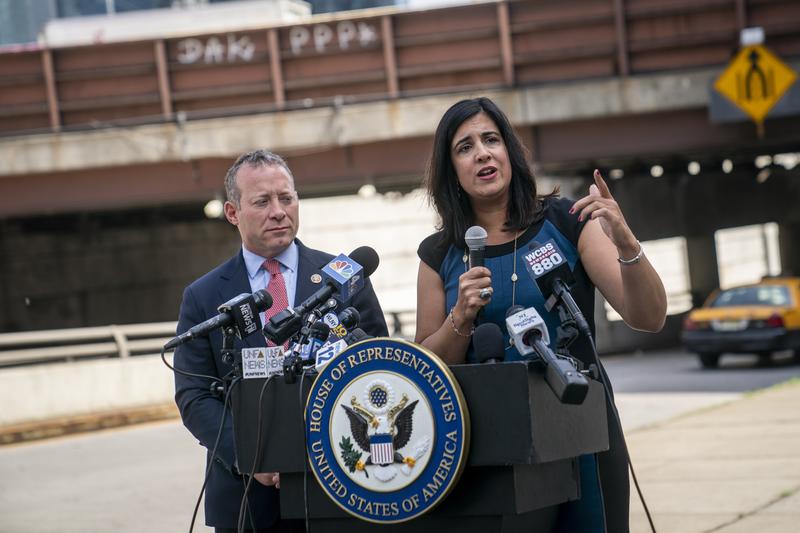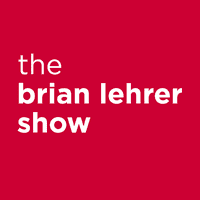Congestion Pricing Is One Step Closer to Reality

( John Minchillo / AP Photo )
[music]
Brian Lehrer: It's the Brian Lehrer Show on WNYC. Good morning, everyone. We'll begin today on a topic everyone loves to talk about in the New York City area, driving and mass transit. There are two significant pieces of transit and transportation news this week. A new kind of subway turnstile coming to a station near you to make fare evasion harder, but how will you get in with your stroller or wheelchair? Can you believe that these new gates will be made of glass? We'll get to that.
The much loved and much hated idea of congestion pricing for driving into Manhattan below 96th Street took a big step closer to becoming reality with a near-final approval by the federal government, but they want some drivers to be exempt, at least in part, sort of simple, but sort of complicated. It's a good thing we have our friendly neighborhood transportation reporter, Stephen Nessen here, to break it all down. Morning Steve, thanks for coming on the show.
Stephen Nessen: Good morning, Brian. Great to be here.
Brian Lehrer: First, I have to ask if you recovered from your all-nighter this week. I heard you were out there with a guy trying to break the record time for passing through every subway stop. Would you remind us what that involved for you as a reporter covering it?
Stephen Nessen: Sure. It's called the Subway Challenge, and it actually had been a few years since anyone attempted it because service was so unpredictable during the pandemic, but folks are back at it, trying again. For me as a reporter, I went to meet a man, his name's Daniel Wells, he's 29 years old, and I met him at 1:00 AM. in Far Rockaway, where the journey begins.
If anyone tried to do the subway challenge, or tried to conceive of what is the fastest way to visit every single subway stop, you'll know that the A-train is really the one you want to knock out first. It's long, and it's also got those little shuttle extensions. I'm sitting across from Bridget right now, who lives near one of those. You got to knock that out first.
That's where I started, and we made it all the way up to Washington Heights, which, you know well, Brian, it's a long journey. We cut over to the one train to knock that out, rode it all the way downtown. Let me just say, after four hours, we had done, essentially, two lines or two-and-a-half lines, maybe. It's a long journey. I had to dip out after seven hours. I was dehydrated, exhausted, my head was throbbing. It's a lot of work. You have to record every stop you make, the time the doors open, the time the doors close. He needs to take a photo of every single station to prove that he was there at that time.
Brian Lehrer: How did he handle lines that go off by themselves, like the number one or the number seven trains? Did he have to go all the way up to 242nd street in the Bronx under one, or all the way out to Flushing-Main Street on the seven, and then back on the same lines, repeating a whole bunch of stops to get back to a transfer point that he hadn't been at before?
Stephen Nessen: Part of the fun, I think, for folks who do this sort of thing, is the prep work before you do that. You put all the lines, all the timing, all the schedules into a spreadsheet, and you find what is the most efficient way to avoid that sort of repetition. I should add, Brian, everyone that's done it in recent times, anyways, the last several years, ends on the 7 train, ends in Flushing.
Brian Lehrer: What's the record time? Do you know?
Stephen Nessen: The current record time is 22 hours, 14 minutes, and 10 seconds, and that's from Kate Jones, a former New Yorker living in Switzerland who broke it just last April. The man that I followed did not break her record.
Brian Lehrer: Enough silliness. Now to get people as aggravated as possible, let's talk about congestion pricing, the plan to charge for driving into Manhattan below 96th Street for the sake of climate protection and centrally, mass transit funding, as well as to fight traffic congestion itself. Remind me, if this would be a toll just for driving within New York City, why does the federal government get a say on the rules?
Stephen Nessen: It's because they are charging on city streets, first of all, and there's an environmental impact on parts of road that do receive some federal funding. I believe, technically, that's why the federal government needs to weigh in on this.
Brian Lehrer: Let's go down some of what Washington came down with. One thing is a limit on how taxis and other for-hire vehicles could be charged?
Stephen Nessen: Right. They came up with some new details that we hadn't heard before, new requirements really, to mitigate the impact on people who they think may be disproportionately impacted by a toll. They found that taxis and for-hire vehicles should only be charged once a day. We should remind folks, I'm sure taxi drivers know it, they're already getting a congestion charge. For-hire vehicles, I think it's $2.75, and taxis are $2.50.
Brian Lehrer: Another limit from the feds is on congestion pricing overnight.
Stephen Nessen: Right. Another requirement is that the overnight charge, from midnight to 4:00 AM, has to below 50% of what the peak hour toll is. If the peak hour toll is $20, the midnight toll has to be at least $10 or less, or if they suggest maybe not charging at all.
Brian Lehrer: Taxis and Ubers, and things like that, only one charge per day, 50% off, at least, for coming into the business district overnight. Washington gave a blueprint for reduced tolling for people who make under $50,000 a year. How would that work?
Stephen Nessen: People who make up to $50,000 a year would get a congestion pricing discount for five years. The way the feds recommended it anyways, is that those drivers will get 25% off the toll after making 10 trips in a calendar month. Calculate that. They do estimate, based on the numbers they have, that this would really only impact about 16,000 people.
Brian Lehrer: Only that many people make under $50,000 a year and drive into Manhattan below 96th Street at least 10 times in a month.
Stephen Nessen: Below 60th Street.
Brian Lehrer: Below 60th Street. That is an interesting one. The idea that some people, with lower incomes, have to drive into the business district, is a critique we often hear of the whole thing. For whatever reason, they can't take mass transit for their jobs, whatever, and they would be the ones who drive in that frequently with lower incomes 10 times a month or more. That's who the federal government says should qualify for an income-based discount?
Stephen Nessen: That's right. Also, the original legislation you may remember, does give a discount to Manhattan residents who make under $60,000 a year. They would also get a discount.
Brian Lehrer: All of those mandated discounts that we just went through do not say how much the basic congestion pricing toll would be. How close are we to knowing what that is?
Stephen Nessen: We still don't know. You may recall from our previous discussions, there's actually a group that was established that needs to set that toll, it's called the Traffic Mobility Review Board. They haven't met yet, but I believe they will be meeting soon now that things are progressing. I think the letter from the feds allows a 30-day waiting period, and then it's the final federal approval, and then the Traffic Mobility Review Board can meet and start to set the rates, the exemptions, and they'll let the board know what tolling scheme that they come up with.
Brian Lehrer: Can people appeal or groups appeal these guidelines we've just been discussing? I definitely heard your point about how the low income reduction or discount applies to so few people making under $50,000 in New York City. 16,000 people only, that's such a tiny fraction of people in that income group.
Stephen Nessen: As the MTAs pointed out, and the feds agree with, the vast majority of people that get into New York, into Manhattan, into the central business district, do so on mass transit. Even our neighbors across the way in New Jersey, who you've certainly heard are thumping their chests and getting very angry about the impending toll, they want discounts, they want to exempt New Jersey residents.
When you talk about who's going to comment, they're commenting, they're filing letters. Even Senator Booker and Menéndez sent a letter to Pete Buttigieg at DOT, to ask him to exempt New Jersey residents, to give them some sort of break. There is a 30-day public comment period now, for which people can lodge their complaints. I suppose the MTA or the feds could add additional requirements after that time, but it doesn't seem likely.
I should add, there's threats of legislation, there's threats of lawsuits from Governor Murphy, from Josh Gottheimer, a Congress member who is bending with some New York Republicans and trying to halt the congestion pricing program. There's nothing serious yet that we can report on. It's threats at this point.
Brian Lehrer: Your reporting reminds us that New York State Law forbids tolling on the FDR Drive in the West Side Highway. Does that mean anyone can avoid the congestion pricing toll once it takes effect just by going downtown on those roads?
Stephen Nessen: Sure. I think the idea is to keep cars out of Manhattan, out of the most congested part of New York City, but if folks don't need to come in Manhattan, I think that's great with the MTA and everyone else. Don't come in. Drive around. Go somewhere else. That is also part of the concern from advocates that folks are going to make some different routes that could cause pollution in different neighborhoods than it had before, increased truck traffic. Especially in the Bronx, we've heard a lot of concerns about that from folks avoiding the toll.
Brian Lehrer: Did the federal government weigh in on that at all? If this was supposed to be an environmental review by Washington, certainly one of the environmental concerns is, as we've discussed on the show, as you just referred to, trucks avoiding the toll by going even more frequently on the Cross Bronx Expressway, the neighbors of which already suffer very high pollution from the road.
Stephen Nessen: Yes, absolutely. There is an entire new page in the environmental assessment from the feds that does require the MTA to use some of the money from congestion pricing on health environmental benefits. $207.5 million would go to mitigate pollution. There's a whole bunch of things they recommend. I'll just give you a couple of the top items. One, which especially impacts the Bronx, the Hunts Point Produce Market, they have a lot of diesel-burning refrigeration trucks. The MTA says those trucks alone create as much carbon emissions as all the cars in Manhattan.
Part of the congestion pricing money, $15 million of it, will be used to start to replace the diesel-burning trucks with electric ones. They will also spend $10 million to install air filters in schools that are near the highway as well as $25 million to renovate parks in what they call the justice communities, which I think is a phrase for low-income neighborhoods that are going to be impacted by congestion pricing.
Brian Lehrer: Before we transition to our one final transit topic, you remind us in your article, just so everybody remembers the basic context here, that the congestion pricing bill that was passed in Albany four years ago requires that they raise $1 billion a year with the toll and that they use the money to pay for $15 billion in bonds to finance mass transit upgrades, as well as significantly reducing traffic below 60th Street.
All right. Briefly on the other transit story which is in the news today, the MTA is planning its first major redesign of subway turnstiles in modern history, we are reporting, a change officials said is key to cracking down on subway fare revision which cost the agency about $285 million last year. They include new doors that are made of glass. Glass, Stephen? Subway gates made of glass?
Stephen Nessen: Well, can I just add one thing, Brian? All of the fare evasion, it's actually $690 million. The subways are just $285 million.
Brian Lehrer: Which, as much as people talk about fare evasion on the subways, I guess you're telling me it really takes place mostly on the buses?
Stephen Nessen: That's right. 37% of bus riders skip out on the fare according to the MTA's research, and it costs them $315 million. It's a lot more than the subways.
Brian Lehrer: All right. Subway gates made of glass?
Stephen Nessen: Well, the MTA, they actually already have one new type of turnstile. It's at three stations right now, Jay Street, Atlantic-Barclays, and Sutphin-Archer. It's like a thick, durable glass, but as we know, New Yorkers will destroy anything in public. These are used in France, in London, in Boston. This is not a new technology in anywhere in the world. I guess it'll be a new obstacle for New Yorkers to destroy.
I will add, yesterday the MTA unveiled four different prototypes. They're very much designed to prevent people from hopping the turnstile, which is so common. A New York Post reporter, Nolan Hicks, actually attempted to hop the turnstile. He's wearing a suit and he had his messenger bag on and he fell on his butt. Couldn't do it. I don't know how fit he is, but it was a good example of how they're designed to deter fare evasion.
Brian Lehrer: What about people with strollers or in wheelchairs and things like that?
Stephen Nessen: Well, they definitely have ADA compliance in mind. I think the ones that are being piloted now at Jay Street replace the exit gate, so it's wide enough for strollers and wheelchairs, of course.
Brian Lehrer: That's where the glass comes in, if I'm not mistaken, sliding glass doors to replace the current swinging metal gates?
Stephen Nessen: Right. That's right.
Brian Lehrer: Why not stay with metal? You can't take a hammer and smash a metal gate and get in.
Stephen Nessen: It's true. I don't know how the mechanics of that work, opening and closing multiple times a day. I'm not an engineer or a designer, but I think structurally, it's probably more like a hard plastic-glass combination thing, would be more durable for opening and closing multiple times. [laughs]
Brian Lehrer: No new proposal for the buses?
Stephen Nessen: No. In fact, we haven't heard about it. They're supposed to be doing all-door boarding with OMNY in the front and the back of not just the SBS buses but all buses. They've slow-walked that for multiple reasons, not all of which are clear to me. That is supposed to help people actually pay the fare because maybe folks are just getting on a crowded bus and they want to get where they're going. They don't want to wait in line and go to the front. It's not clear exactly what the MTA is doing other than sending Eagle Teams, folks to check whether you paid or not using the stick, not the carrot.
Brian Lehrer: I've been so careful to use my MetroCard to get the little paper receipt that you take onto the Select Bus Service routes because I've seen an inspector board the bus at a random stop and walk up and down and check for people's receipts and I didn't get one of those tickets. Now I realize that a third of the people aren't doing it at all.
Stephen Nessen: That's right. You could use OMNY, Brian. It's pretty convenient.
Brian Lehrer: Well, I use it to get in the subway so far. Stephen Nessen, who covers transportation, here for WNYC and Gothamist, and tweets at the handle, just your friendly neighborhood transit reporter. Thanks as always, Stephen.
Stephen Nessen: Thank you, Brian.
Brian Lehrer: Brian Lehrer on WNYC. Much more to come.
Copyright © 2023 New York Public Radio. All rights reserved. Visit our website terms of use at www.wnyc.org for further information.
New York Public Radio transcripts are created on a rush deadline, often by contractors. This text may not be in its final form and may be updated or revised in the future. Accuracy and availability may vary. The authoritative record of New York Public Radio’s programming is the audio record.

